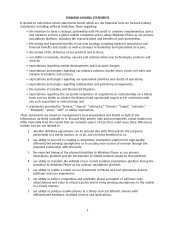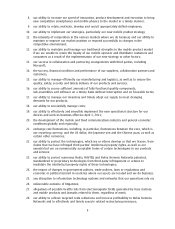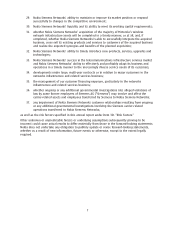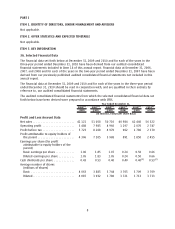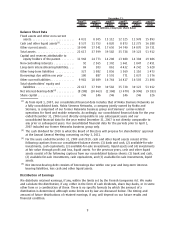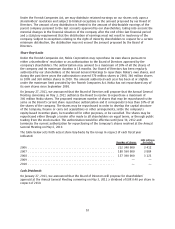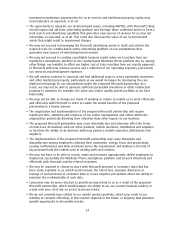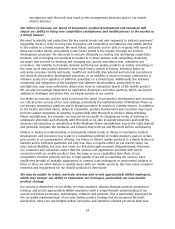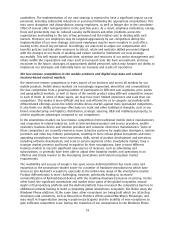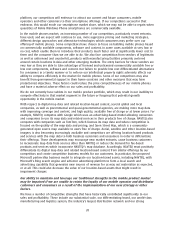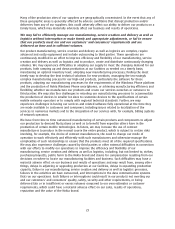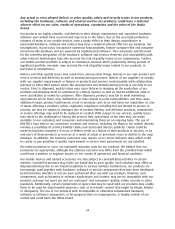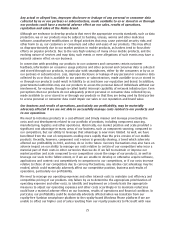Nokia 2010 Annual Report Download - page 16
Download and view the complete annual report
Please find page 16 of the 2010 Nokia annual report below. You can navigate through the pages in the report by either clicking on the pages listed below, or by using the keyword search tool below to find specific information within the annual report.• The assessment of our proposed partnership with Microsoft and new strategy could cause
lowered credit ratings of our short and longterm debt or their outlook from the credit rating
agencies and, consequently, impair our ability to raise new financing or refinance our current
borrowings and increase our interest costs associated with any new debt instruments.
We may not be able to maintain the viability of our current Symbian smartphone platform
during the transition to Windows Phone as our primary smartphone platform or we may not
realize a return on our investment in MeeGo and next generation devices, platforms and user
experiences.
The continued viability of our Symbian smartphones, even as we plan to deliver additional user
interface and hardware enhancements, during the transition to Windows Phone as our primary
smartphone platform is subject to certain risks and uncertainties, which could, either individually or
together, significantly impair our market share, net sales and profitability. Those risks and
uncertainties include the following:
• Our mobile operator and distributor customers and consumers may no longer see our Symbian
smartphones as attractive investments during the transition to Windows Phone. This would
result in a loss of market share, which could be substantial, during the transition and which
we may not be able to regain when quantities of Nokia Windows Phone smartphones are
commercially available.
• We may not succeed in transitioning over time our installed base of Symbian owners to our
Windows Phone smartphones.
• Application, services and content development by developers and other partners for Symbian
may decline or cease, which would diminish the viability of our Symbian smartphones and
their attractiveness to our mobile operator and distributor customers and consumers, as well
as limit the opportunity to transition compatible aspects of our Symbian development to the
Windows Phone ecosystem.
• Our mobile operator and distributor customers may choose not to promote and market
robustly some or all of our Symbian smartphones, may require monetary incentives, including
significant price reductions, to do so or may discontinue some or all of our Symbian
smartphone product lines.
• Our suppliers may reduce the availability of certain components for our Symbian smartphones
or we may not be able to obtain certain or sufficient components for our Symbian
smartphones at attractive prices resulting in increased costs that we may not be able to pass
on to our customers.
• We may not be able to provide the necessary support for our Symbian smartphones
organization and business during the transition to Windows Phone, including efficiently
managing the phaseout over time of our investment in Symbian while maintaining acceptable
profitability for those products.
• We may lose key personnel and skilled employees involved in the development of our Symbian
platform. We may also not be able to maintain employee motivation and focus to continue to
innovate and develop on the Symbian smartphone platform or otherwise be able to maintain
the quality of our Symbian smartphones.
• Under our new strategy, MeeGo becomes an opensource, mobile platform project. Our
investment in MeeGo will emphasize longerterm market exploration of nextgeneration
devices, platforms and user experiences. We plan to ship a MeeGobased mobile product later
this year. If the market segment that we target with that mobile product does not materialize
as expected, or if we fail to develop nextgeneration platforms, user experiences and mobile
products, we may incur operating losses and accordingly not realize a return on our
investment in this area.
15


